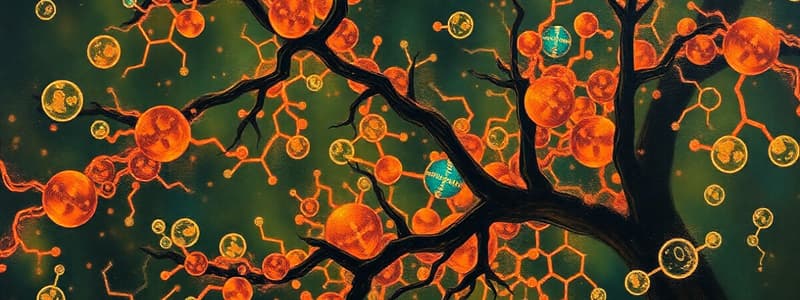Podcast
Questions and Answers
What is the term for the protein component of an enzyme that requires a cofactor to be active?
What is the term for the protein component of an enzyme that requires a cofactor to be active?
Which term describes a substance that reduces the rate of an enzyme-catalyzed reaction?
Which term describes a substance that reduces the rate of an enzyme-catalyzed reaction?
What units are used to measure enzyme activity?
What units are used to measure enzyme activity?
What does 'Km' represent in enzyme kinetics?
What does 'Km' represent in enzyme kinetics?
Signup and view all the answers
What term describes the temperature at which an enzyme shows maximum activity?
What term describes the temperature at which an enzyme shows maximum activity?
Signup and view all the answers
Which of the following is NOT a factor affecting enzyme activity?
Which of the following is NOT a factor affecting enzyme activity?
Signup and view all the answers
A thermophilic bacterial enzyme would likely have its optimum temperature closest to which temperature?
A thermophilic bacterial enzyme would likely have its optimum temperature closest to which temperature?
Signup and view all the answers
What does a low Km indicate about an enzyme?
What does a low Km indicate about an enzyme?
Signup and view all the answers
What is the primary function of a catalyst in a chemical reaction?
What is the primary function of a catalyst in a chemical reaction?
Signup and view all the answers
Which of the following best describes the relationship between enzymes and the equilibrium of a chemical reaction?
Which of the following best describes the relationship between enzymes and the equilibrium of a chemical reaction?
Signup and view all the answers
What is the primary difference between an enzyme and a ribozyme?
What is the primary difference between an enzyme and a ribozyme?
Signup and view all the answers
Which statement correctly explains the concept of enzyme 'specificity'?
Which statement correctly explains the concept of enzyme 'specificity'?
Signup and view all the answers
According to the enzyme classification system, what type of enzyme is 'hydrolase'?
According to the enzyme classification system, what type of enzyme is 'hydrolase'?
Signup and view all the answers
What is the purpose of the serial number in the EC number system for enzymes?
What is the purpose of the serial number in the EC number system for enzymes?
Signup and view all the answers
If an enzyme-catalyzed reaction is said to be '10^6 times faster than uncatalyzed reactions', which enzyme is most likely being described?
If an enzyme-catalyzed reaction is said to be '10^6 times faster than uncatalyzed reactions', which enzyme is most likely being described?
Signup and view all the answers
An enzyme is found to be using chemically related molecules as its substrates. Which aspect of enzyme properties is described here?
An enzyme is found to be using chemically related molecules as its substrates. Which aspect of enzyme properties is described here?
Signup and view all the answers
Flashcards
Apoenzyme
Apoenzyme
The protein component of an enzyme.
Cofactor
Cofactor
The non-protein component of an enzyme, often a metal ion or organic molecule.
Holoenzyme
Holoenzyme
The active form of an enzyme, containing both the protein (apoenzyme) and non-protein (cofactor) components.
Active Site
Active Site
Signup and view all the flashcards
Enzyme Activity
Enzyme Activity
Signup and view all the flashcards
Optimum Temperature
Optimum Temperature
Signup and view all the flashcards
Optimum pH
Optimum pH
Signup and view all the flashcards
Inhibitor
Inhibitor
Signup and view all the flashcards
Enzymes
Enzymes
Signup and view all the flashcards
What are enzymes made of?
What are enzymes made of?
Signup and view all the flashcards
Do enzymes change the outcome of a reaction?
Do enzymes change the outcome of a reaction?
Signup and view all the flashcards
What is enzyme specificity?
What is enzyme specificity?
Signup and view all the flashcards
How are enzymes classified?
How are enzymes classified?
Signup and view all the flashcards
How efficient are enzymes?
How efficient are enzymes?
Signup and view all the flashcards
What is Activation Energy?
What is Activation Energy?
Signup and view all the flashcards
What are catalysts?
What are catalysts?
Signup and view all the flashcards
Study Notes
Enzymes
- Enzymes are biocatalysts that speed up biochemical reactions
- They are not consumed in the reaction
- Enzymes lower the activation energy needed for a chemical reaction to occur
- Enzymes are specific to the reaction and the substrate
Learning Objectives
- Describe enzymes and their common properties
- List enzyme classifications in the correct order
- Describe factors that change enzyme activity
- Explain the relationship between Km and activity
- Explain enzyme inhibition and inhibition types
Metabolic Reactions
- Enzymes facilitate both anabolic and catabolic reactions
- Enzymes facilitate metabolic reactions by decreasing activation energy and increasing reaction rate
- Enzymes can modify molecules
- Enzymes can transport molecules
Glycolysis
- Glycolysis is a metabolic pathway involving reactions on molecules, catalyzed by enzymes such as Hexokinase (HK) and Phosphofructokinase (PFK), to break down glucose
- Illustrated in detail on slide 4
Enzyme Nomenclature: Classification
- Enzymes are classified based on their catalytic function (EC numbers)
- Includes classes like Oxidoreductases, Transferases, Hydrolases, Lyases, Isomerases, Ligases, and Translocases
- The classification system is standardized by the International Union of Biochemistry and Molecular Biology (IUBMB)
Properties of Enzymes
- Most enzymes are proteins (with exceptions like ribozymes)
- Enzymes are highly specific for the substrates they act on and the reaction they catalyze
- They increase reaction rates without altering the reaction equilibrium
- The illustration on slide 9 displays substrate to reaction specificity
Efficiency
- Enzyme-catalyzed reactions are highly efficient, proceeding 103 to 108 times faster than uncatalyzed reactions
- Enzymes like carbonic anhydrase are among the fastest known enzymes hydrating 106 molecules of CO2 per second
Specificity
- Reaction Specificity: A given enzyme catalyzes a specific type of reaction
- Substrate Specificity: A given enzyme uses specific molecules or chemically related ones
Enzyme Activity
- Activity is measured as the speed (V)
- It's the number of substrate molecules that become products in given time
- The unit is the amount of substrate conversions in a minute, under optimal conditions
Factors Affecting Enzyme Activity
- Enzyme concentration: More enzyme, faster reaction
- Substrate concentration: Up to a point, more substrate, faster reaction
- Temperature: Optimal temperature for maximum activity
- Humans (35-40°C); Thermophilic bacteria (70°C).
- pH: Optimal pH for maximum enzyme activity
- Inhibitors: Reduce enzyme activity
Enzyme Concentration
- Increase in enzyme concentration increases product concentration and reaction speed
Substrate Concentration
- Increase in substrate concentration increases reaction speed until saturation point is reached
- Km (Michaelis-Menten constant): Substrate concentration at which reaction velocity is half of Vmax (maximum reaction rate)
- Higher Km means lower affinity of enzyme for the substrate
Temperature
- Temperature affects enzyme activity, with an optimal temperature for each enzyme
- Excessive heat can denature enzymes, reducing their ability to function
pH
- pH affects enzyme activity, with an optimal pH for each enzyme
- Significant deviations from optimal pH can denature enzymes
Inhibitors
- Inhibitors decrease enzyme activity
- Two main types: reversible and irreversible
- Competitive inhibitors block the active site
- Non-competitive inhibitors change the enzyme shape, making the active site unavailable
Enzyme Kinetics and Km
- Km represents the enzyme's affinity for its substrate
- Low Km indicates high affinity
Km, A Clinical Example
- Enzyme Km values are clinically relevant; for example, alcohol dehydrogenase's Km value influences how quickly the body processes alcohol
Regulation of Enzyme Activity
- Enzymes are regulated in several ways, including enzyme synthesis, enzyme degradation and through modulation of the catalytic activity
Regulation of Enzyme Activity (Continued)
- Enzyme amount, enzyme modification, covalent modification, and compartments
- Negative feedback, feed-forward activation, regulation through location
- Phosphorylation/dephosphorylation; other modes of regulation, such as isozymes.
Studying That Suits You
Use AI to generate personalized quizzes and flashcards to suit your learning preferences.
Related Documents
Description
This quiz covers the role of enzymes as biocatalysts in biochemical reactions, focusing on their properties, classifications, and activities. It also explores glycolysis and the specific enzymes involved in the metabolic breakdown of glucose. Test your understanding of enzyme function and regulation through various questions.




